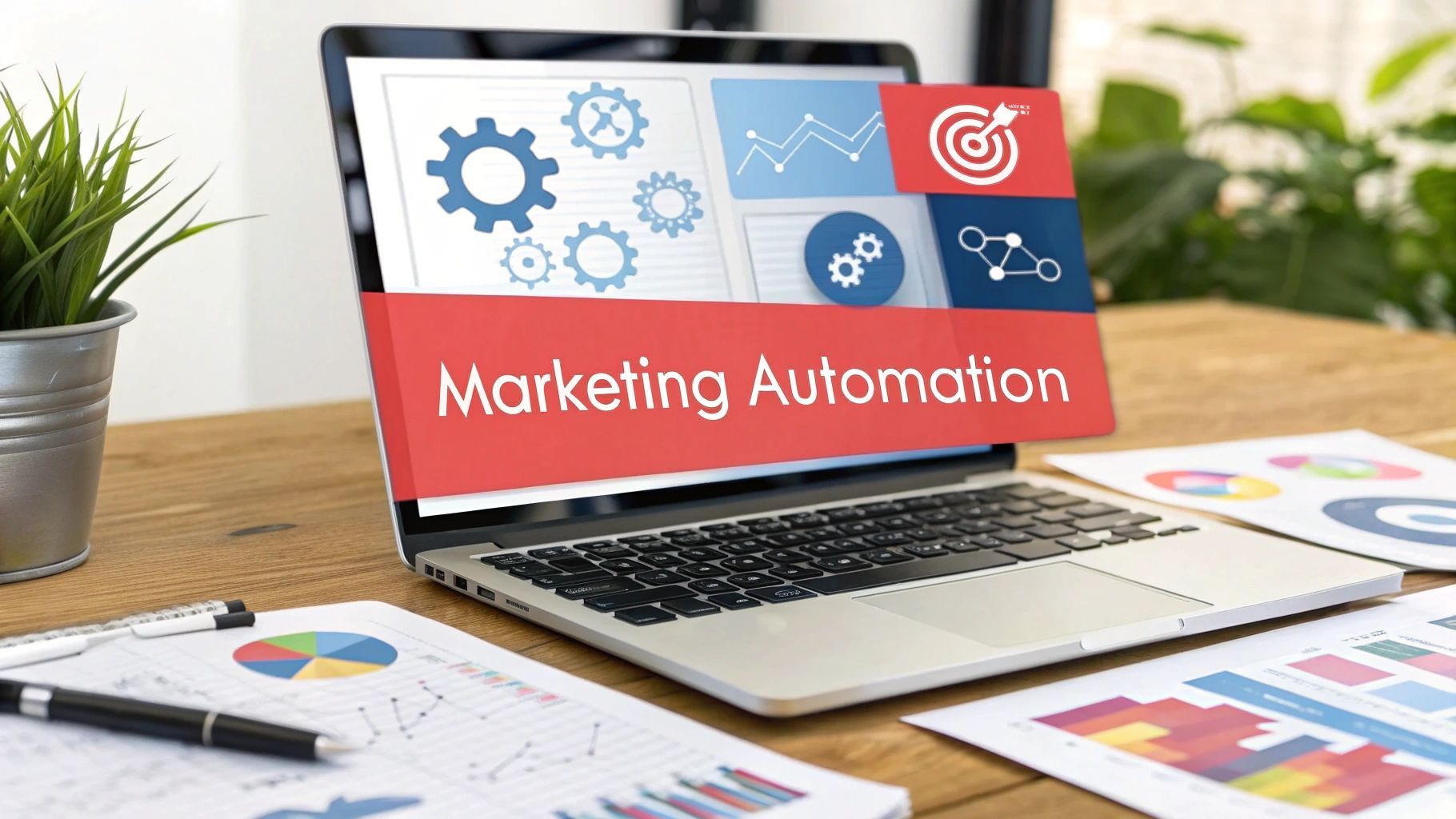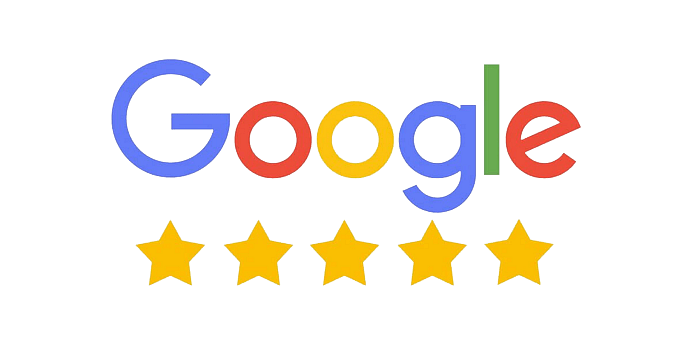Social Media for Small Business: Boost Growth Today
For any small business today, using social media is not just a "nice-to-have" anymore—it is a core part of staying in business. Think of it as your new high street, a bustling digital space where customers find you, chat with you and get to know the people behind the brand.
Why Social Media Is Essential for Your Business
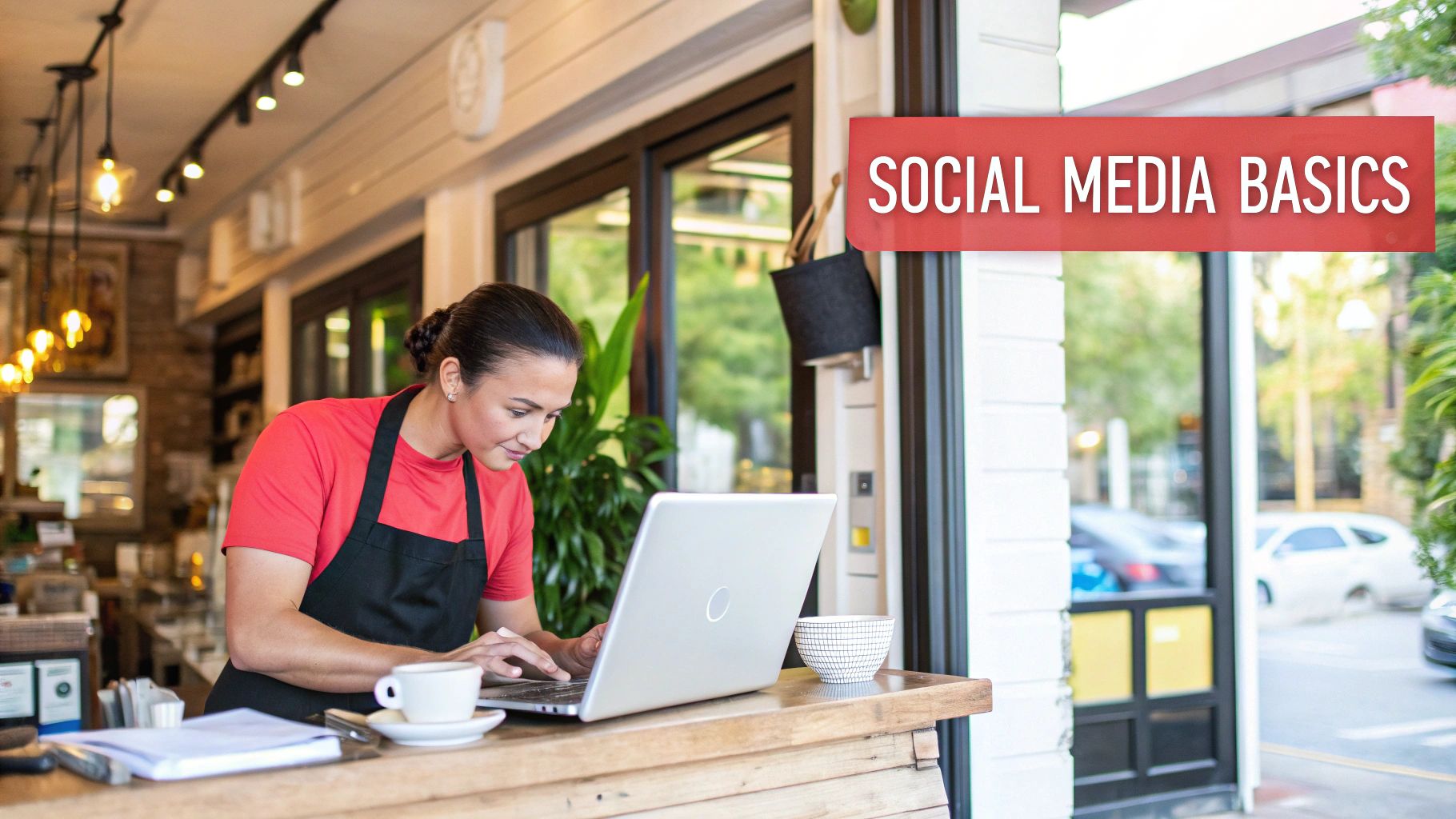
Trying to run a business without social media is like having a shop on the busiest street in town but keeping the shutters down all day. You can see potential customers walking right past but you're invisible, missing out on every single chance to say hello, make a connection and invite them in.
These days, the customer journey rarely starts with a walk-in. It begins online. People expect to find you on places like Instagram, Facebook or even LinkedIn. They want to scroll through your products, see what other people are saying and get a real sense of your brand's personality long before they think about spending any money. Your social profile is your new shop window.
Building Connections and Driving Growth
A clever social media plan does more than just get your name out there. It is the great equaliser, letting you go toe-to-toe with bigger companies without needing a massive budget. By having real conversations and showing the human side of your business, you can build the kind of loyalty that money cannot buy.
Just look at the benefits:
- Increased Brand Awareness: You can reach people who might never have stumbled across your website or physical shop.
- Direct Customer Engagement: It is a chance to build a proper community through comments, direct messages and shared posts.
- Cost-Effective Marketing: You can make a huge impact without the eye-watering costs of old-school advertising.
- Valuable Customer Insights: Listening to what people are saying gives you a direct line into what your customers actually want.
This connection is incredibly powerful. It turns marketing from a one-way street into a genuine conversation, creating loyal fans who not only buy from you but tell their friends to do the same. For a deeper dive, this guide on social media marketing for small businesses is a great resource.
The Scale of Opportunity in the UK
The numbers alone tell the story. As of January 2023, more than 79% of the UK population —that is about 54.8 million people—were active on social media. That is not just a statistic; it is a massive, ready-made audience waiting to be engaged. This fundamental shift in how people shop and interact shows exactly why social media is so important.
A well-crafted social media strategy is no longer optional but critical for small business survival and growth in the UK market. Ignoring this digital foot traffic means actively losing out on brand awareness and revenue.
When you get right down to it, putting time and effort into your social media is a direct investment in the future of your business. It is all about meeting your customers where they already are and building relationships that last.
Choosing the Right Social Media Platforms
Jumping into social media for the first time can feel like you have been asked to be in a dozen places at once. The temptation is to sign up for everything, hoping that casting a wide net will catch more fish. But this approach usually just leads to burnout and a message that is too diluted to make an impact.
The secret is not being everywhere. It is being everywhere your customers are.
The first and most important question you need to ask is: "Where do my ideal customers actually hang out online?" Every platform has its own vibe, its own community and its own way of communicating. Getting to grips with these differences is the first step towards a smart, focused strategy that actually pays off.
Aligning Platforms with Your Business Goals
Think of social media platforms as different venues. LinkedIn is a professional networking event, perfect for B2B connections. Instagram is like a vibrant art gallery, built for showing off beautiful products. TikTok is a lively street performance, all about short, sharp and entertaining content. You would not try to sell intricate handmade jewellery at a corporate conference, would you? The same logic applies here.
Your business type and goals will naturally point you towards the right platforms. A B2B consultancy, for instance, will find its audience of decision-makers on LinkedIn. On the other hand, a local bakery or a bespoke furniture maker will thrive on the visual-first nature of Instagram and Pinterest, where aesthetics are everything.
Choosing the right platform is about strategic presence, not universal presence. Focus your energy where it will have the most impact by aligning your business with the platform's core audience and purpose.
This simple breakdown shows the main benefits you can expect from a well-managed social media presence.
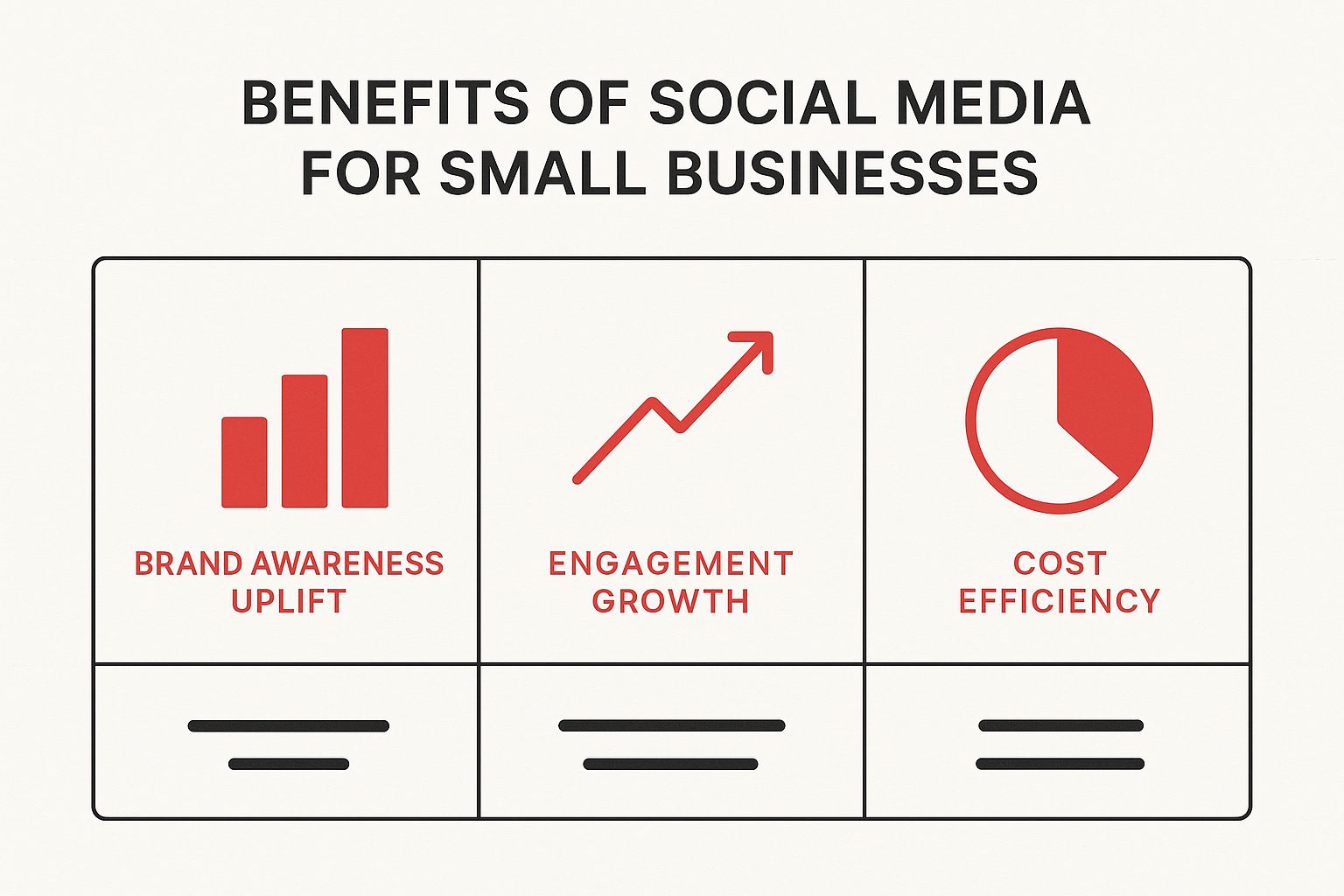
As you can see, the benefits go far beyond just making sales. A focused strategy helps build brand recognition and can even be more cost-effective than traditional advertising.
A Look at the Major UK Platforms
To make the right call, you need to understand the unique landscape of each major platform here in the UK. Let us take a look.
-
Facebook: With over 55.9 million UK users in early 2025, Facebook is still a giant. Its main strength is its sheer diversity and brilliant community-building tools like Groups. It is fantastic for local businesses wanting to connect with their neighbourhood and for anyone targeting a broad demographic.
-
Instagram: This is the home of visual storytelling. If you sell products or services that look great on camera—from artisan food to interior design—Instagram is a must. Its focus on high-quality images, Reels and Stories is perfect for brands with a strong visual identity.
-
LinkedIn: This is the definitive platform for business-to-business (B2B) companies. It is where professionals connect, share industry insights and look for expert services. If your customers are other businesses, a strong LinkedIn presence is non-negotiable.
-
TikTok: Dominated by fast-paced, entertaining video, TikTok is your go-to for reaching a younger audience. Brands that do well here are creative, authentic and are not afraid to have a bit of fun. It is a powerful tool for generating huge brand awareness if your content hits the right note.
-
X (formerly Twitter): X is all about what is happening right now. Think real-time conversations, breaking news and quick-fire customer service. It is a great place to join industry discussions and engage directly with customers.
To help you decide, here is a quick comparison of the main players.
Platform Selection Guide for UK Small Businesses
| Platform | Primary Audience (UK) | Best For (Business Type) | Key Content Format |
|---|---|---|---|
| Broad (Gen X, Millennials, Boomers) | Local services, community-focused brands, e-commerce | Posts, videos, Stories, Groups | |
| Younger (Gen Z, Millennials) | Visual products (fashion, food, design), lifestyle brands | High-quality images, Reels, Stories | |
| Professionals (all ages) | B2B services, consulting, professional recruitment | Articles, professional updates, case studies | |
| TikTok | Youth (Gen Z, younger Millennials) | Brands targeting younger demographics, entertainment | Short-form, trend-led videos |
| X (Twitter) | News followers, professionals (Millennials, Gen X) | Tech, news, customer service, B2B engagement | Short text updates, polls, threads |
This table is just a starting point but it illustrates how each platform serves a different purpose.
Recent data confirms that UK small businesses are already using this kind of strategic thinking. Research from 2023 showed how entrepreneurs pick platforms based on their specific goals—retailers flock to Instagram for its visual appeal, while others use Facebook for its massive reach. You can find more social media usage stats for UK small businesses on Statista.
The best advice? Start small. Choose one or two platforms that feel like a natural fit for your brand and your audience. Get really good at them, build a genuine community and only then should you think about expanding. A focused approach is always more sustainable and ultimately more successful.
Building a Content Strategy That Connects
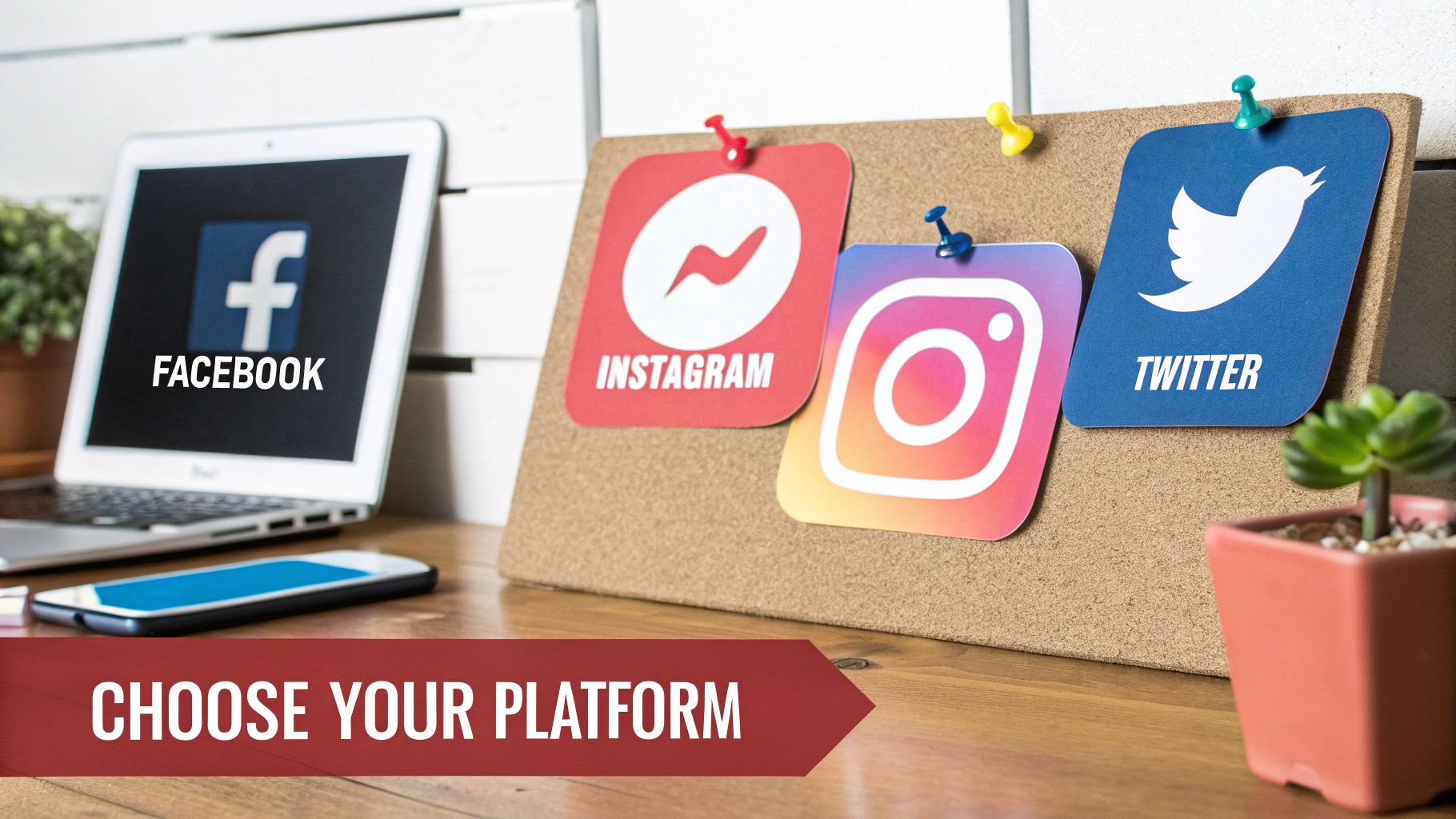
So, you have picked your platforms. What now? A common mistake is to post randomly, whenever the mood strikes. That is a bit like shouting into a crowded room, hoping the right person hears you. To really make an impact, your small business needs a clear content strategy that turns sporadic updates into purposeful communication.
This is not just about selling. It is about creating content that educates, entertains and genuinely connects with people. The aim is to give your audience a reason to follow you that goes far beyond just waiting for your next sale.
Defining Your Content Pillars
The very foundation of a solid strategy is your content pillars . Think of them as three to five core topics or themes your business can talk about with real authority. These pillars should live right at the intersection of your expertise and your audience’s interests.
A local fitness studio, for instance, might build its strategy on these pillars:
- Workout Tips: Sharing quick, effective exercise routines.
- Nutrition Advice: Offering simple recipes and healthy eating guidance.
- Member Spotlights: Celebrating the progress and stories of their clients.
- Behind the Scenes: Showing the friendly faces of the trainers and the gym's atmosphere.
Having pillars like these gives your content direction and keeps everything you post consistent with your brand. It also makes brainstorming new ideas so much easier because you always have a solid starting point.
Creating a Balanced Content Mix
With your pillars in place, the next job is to create a varied mix of content. Sticking to a single format gets repetitive and your audience will quickly switch off. A more dynamic approach keeps your feed fresh and appeals to a wider range of people.
It is also crucial to understand how these platforms actually decide who sees your posts. Getting a handle on how social media algorithms work can make a massive difference to your reach and engagement.
Try blending these four key types of content:
- Educational: Offer real value with how-to guides, handy tips or industry insights. This builds trust and positions you as an expert.
- Entertaining: Use a bit of humour, share fun facts or create engaging videos to show off your brand's personality. This is the stuff people love to share.
- Inspirational: Post customer success stories, motivational quotes or a glimpse behind the curtain of your business journey. This forges a much deeper, emotional connection.
- Promotional: This is where you actually talk about your products, services and offers. Keep this to around 20% of your total content so your feed never feels too salesy.
This balanced approach means you are always giving something valuable to your audience, which is the secret to building a loyal community, not just a list of followers.
Organising Your Efforts with a Content Calendar
A great strategy is useless if you cannot manage it without it taking over your life. This is where a content calendar becomes your best friend. It is the key to staying organised and most importantly, consistent.
Your calendar can be a simple spreadsheet or a more advanced scheduling tool—whatever works for you. The point is to plan your posts ahead of time. This helps you keep up a steady posting rhythm and ensures you are covering all your content pillars. For those on a tight budget, looking into content marketing strategies for small businesses on a budget can uncover some really clever, low-cost ways to manage this.
A content calendar does not just organise your posts; it organises your time. By batching content creation and scheduling in advance, you free yourself up to focus on running your business and engaging with your audience in real time.
Several fantastic tools can help automate the scheduling process:
- Hootsuite: A powerful tool that lets you manage and schedule posts across multiple platforms from one dashboard.
- Buffer: Loved for its clean, user-friendly interface and simple scheduling features.
- Later: An excellent choice for visual platforms like Instagram, thanks to its grid planner that shows you exactly how your profile will look.
Using these tools is a massive time-saver. You can block out a couple of hours to plan and schedule all your content for the week or even the whole month. This consistency is exactly what social media platforms reward and it helps you stay top-of-mind with your audience. Ultimately, a well-planned strategy turns social media from a daily chore into a powerful and manageable asset for your business.
How to Engage Your Audience and Build a Community
So, you have got a great content plan. That is a solid start but the real magic of social media, especially for a small business, happens in the conversation. It is all too easy to fall into the trap of just broadcasting your messages like a one-way radio station. The goal is not to talk at your audience; it is to talk with them.
Meaningful engagement is the true measure of success here, far more than just racking up a high follower count. Trust me, a smaller, highly engaged audience is infinitely more valuable than a large, silent one. Your ultimate aim is to turn those followers into a loyal community of people who genuinely champion your brand.
Think of yourself as the friendly local shopkeeper who knows everyone by name. Every comment, like and share is a person walking through your digital door. Acknowledging them and striking up a conversation is how you build relationships that actually last.
Sparking Genuine Interaction
Getting people to engage is not about guesswork; you have to be intentional about it. You need to give your audience clear, simple invitations to join the conversation.
Simple, direct questions are one of the most effective tools in your arsenal. Instead of just posting a picture of your new product, ask your audience what they think of the new colour or how they would use it. This small tweak shifts the dynamic from a monologue to a dialogue.
The interactive features built right into the platforms are your best friend for this.
- Run Polls: Ask for opinions on new ideas, flavour choices or even just fun, light-hearted topics. People love to share their thoughts when it is quick and easy.
- Host Q&A Sessions: Jump on Instagram Stories or Facebook Live to answer customer questions in real time. It shows transparency and makes your brand feel much more human.
- Create Quizzes: A fun quiz related to your industry can be a brilliant way to entertain and educate your audience at the same time.
These tactics do more than just generate comments; they make your audience feel heard, valued and part of something.
The Power of Responding
If you take only one thing away from this section, let it be this: respond to people . Try to reply to every single comment and direct message you receive. Do it promptly and do it personally. This shows you are listening and that you genuinely care about what your customers have to say.
Building a community is not about collecting followers; it is about making connections. Every reply, every acknowledgement and every conversation is a brick in the foundation of a strong, loyal customer base.
This commitment to conversation also means encouraging your audience to create content for you. Sharing photos or reviews from happy customers—what we call user-generated content —is incredibly powerful. It acts as authentic social proof and makes your community feel like they are a central part of your brand's story. You can learn more about the importance of user-generated content in digital marketing and how to get more of it.
Handling Negative Feedback with Grace
Not every interaction is going to be a glowing review and that is perfectly okay. Negative feedback is not something to be feared or even worse, deleted. Instead, you should see it as a golden opportunity to show off your outstanding customer service for everyone to see.
When you are faced with a complaint, follow this simple three-step process:
- Acknowledge Promptly and Publicly: Respond to the comment quickly. Thank them for their feedback and apologise that they had a bad experience.
- Take the Conversation Private: Ask them to send you a direct message with more details so you can sort the issue out personally.
- Learn and Improve: Use that feedback to identify any underlying problems in your business and make genuine improvements.
By handling criticism constructively, you can often turn an unhappy customer into one of your most loyal advocates. This transparent, professional approach builds immense trust with your entire audience, showing that you stand behind your business and are committed to getting things right.
Measuring What Matters with Social Media Analytics

Pouring time and effort into crafting brilliant social media content is only half the story. To really make it work for your small business, you need to know what is hitting the mark and what is falling flat. This is where analytics step in, helping you trade guesswork for a clear, data-backed strategy.
Do not let the word "analytics" put you off. It is not about getting lost in complex spreadsheets. It is simply about paying attention to the right numbers to understand your audience better and make smarter decisions that actually help your business grow.
Moving Beyond Vanity Metrics
It is easy to get a buzz from seeing a post rack up hundreds of 'likes'. These are what we call vanity metrics —they look good on the surface but they do not necessarily lead to real business results. A high like count does not pay the bills or tell you if your message is truly connecting with the right people.
Instead, your focus should be on Key Performance Indicators (KPIs) . These are the metrics tied directly to your business goals, like driving traffic to your website or generating sales leads. They give you a much more honest picture of your return on investment.
Key Metrics That Truly Matter
To get started, you do not need to track dozens of different figures. Just concentrate on a few core KPIs that give you insights you can actually use. Most social media platforms offer free, built-in analytics tools that make finding this information surprisingly straightforward.
Here are the essential metrics every small business should be watching:
- Reach: This is simply the total number of unique people who see your content. A high reach means your posts are getting in front of a wide audience, which is the foundation for building brand awareness.
- Engagement Rate: This tells you how many people who saw your post bothered to interact with it (by liking, commenting or sharing). It is a fantastic indicator of how well your content is resonating.
- Website Clicks: This one is crucial. It tracks how many people clicked a link in your post or bio to visit your website, showing you how effectively your social media is driving traffic to your online home.
- Conversions: For many businesses, this is the ultimate goal. A conversion is when someone takes a specific action after clicking through, like buying a product, signing up for your newsletter or filling out a contact form.
By keeping an eye on these KPIs, you will start to build a clear picture of what your audience responds to. This allows you to fine-tune your content strategy for better results over time.
Think of your analytics as a compass, not a report card. Its purpose is not to judge past performance but to guide your future decisions, pointing you towards the content and strategies that will deliver the best results.
Using Data to Refine Your Strategy
Once you start tracking these metrics, you can begin to spot patterns. For instance, you might notice that your "behind-the-scenes" videos get a much higher engagement rate than your standard promotional posts. That is a clear signal from your audience: they want more of that type of content!
This data-driven approach is more important than ever, especially given how crowded the online space is. In the UK, the social media advertising market is expected to hit £9.95 billion by 2025, which shows just how many businesses are competing for attention. To stand out, you need to understand what works for your specific audience. You can discover more UK social media insights on Sprout Social.
Here is a simple process to put this into practice:
- Check Your Analytics Weekly: Carve out a little time each week to review your key metrics.
- Identify Top-Performing Content: Find the posts with the highest reach and engagement. What did they have in common? Was it the topic, the format, the time of day?
- Analyse Underperforming Content: Just as importantly, look at what did not work so well. Was the copy a bit dry? The image uninspiring?
- Adjust Your Content Plan: Use these findings to shape your content calendar for the weeks ahead. The plan is simple: do more of what works and less of what does not.
This continuous cycle of measuring, learning and adapting is the secret to sustainable growth. It turns your social media from a shot in the dark into a predictable and powerful tool for building your business.
Common Questions About Social Media for Business
Even with the best plan in the world, diving into social media for your business can feel a little daunting. It is completely normal to have those last-minute wobbles and wonder about the day-to-day realities of budgets, time and dealing with tricky customer feedback.
Getting your head around these common questions is the final piece of the puzzle. This section tackles the queries we hear most often from business owners just like you, offering straightforward advice to help you manage your resources and navigate your new online community with confidence.
How Much Should a Small Business Spend on Social Media?
One of the biggest myths I hear about social media is that you need deep pockets to get anywhere. The truth? You can achieve a huge amount without spending a single penny on ads, especially when you are just finding your feet. The trick is to start small and only scale your spending when it makes sense.
Think of your budget in two distinct pots:
- Organic (Free) Efforts: This is all the stuff you do without paying for promotion—creating posts, chatting with your followers and building a genuine community. The only thing you are investing here is your time.
- Paid Advertising: This is when you pay to ‘boost’ posts or run targeted ad campaigns to reach a wider, more specific group of people. This is where a cash budget comes into play.
A really sensible approach is to nail your organic strategy first. Once you have a feel for what kind of content your audience loves, then you can start dipping your toe into advertising. Honestly, even a small budget of £50-£100 per month can be enough to boost your best-performing posts and give your reach a serious lift.
Think of your budget as an investment, not an expense. Start with what you can comfortably afford, keep a close eye on the results and only increase the spend when you can see it is paying off.
How Much Time Do I Need to Dedicate to Social Media Each Week?
For a small business owner, time is gold. The good news is that managing your social media does not have to swallow your entire week. With a clever approach, you can make a real impact in just a few focused hours.
A realistic starting point for most small businesses is somewhere between three and five hours per week . The key is to avoid letting it become a constant, nagging distraction. The best way to do this is a technique called time-batching .
It is simple: you dedicate specific blocks of time to specific jobs. It might look something like this:
- Content Creation (1-2 hours): Block out a couple of hours at the start of the week. This is your time to write captions, design graphics and edit any videos for the days ahead.
- Scheduling (30 minutes): Use a tool to load up all your brilliant content for the week. Set it and forget it.
- Daily Engagement (15-20 minutes): Hop on each day for a short burst to reply to comments, answer messages and interact with other accounts in your niche.
This structured method stops social media from taking over your life. It ensures you stay consistent—which is absolutely vital for growth—and frees you up to get on with the hundred other things involved in running your business.
What Is the Best Way to Handle Negative Comments or Reviews?
Getting negative feedback never feels great but how you react says everything about your business. Hitting the delete button or getting into a slanging match is the worst thing you can do. Instead, try to see these moments for what they are: a golden opportunity to show everyone you are brilliant at customer service.
When a negative comment pops up, just follow this simple, professional process. It will protect your reputation and can often turn an unhappy customer into a loyal fan.
- Respond Quickly and Publicly: Your first move should always be a prompt and polite public reply. Acknowledge their feedback, thank them for bringing it to your attention and offer a genuine apology for their bad experience. This immediately shows everyone else that you take concerns seriously.
- Move the Conversation Offline: In that public reply, invite them to chat privately. A simple, "So we can look into this properly for you, could you please send us a direct message with a few more details?" works perfectly. This takes the heat out of the public domain and allows you to get to the bottom of the issue.
- Learn from the Feedback: After you have resolved the problem, take a step back. Was this a one-off or does the complaint highlight a bigger issue with your product or service? Use that insight to make real improvements to your business.
Following this process shows you are a responsible and caring business owner. It builds trust, not just with the person who complained, but with every potential customer watching to see how you handle pressure.
At Superhub , we specialise in creating effective social media strategies that drive real growth for businesses across the UK. If you are ready to turn your online presence into a powerful asset, find out how our expert team can help you. Learn more about our services at https://www.superhub.biz.



